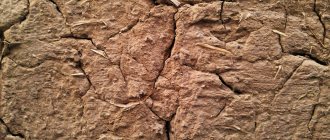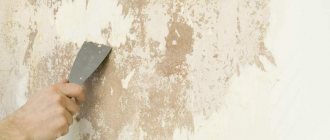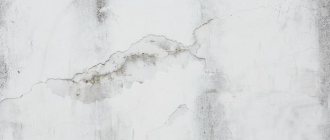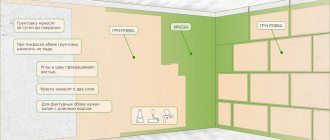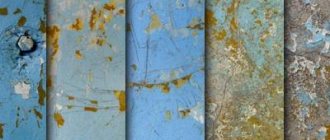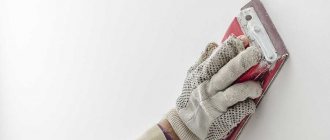Cleaning walls from old oil paint is a rather complex and time-consuming process.
In some areas the coating swells and falls off, but in some places it holds very tightly and does not always respond to the influence of an iron brush or scraper.
How to remove old oil paint from walls at home? The best ways to do this are discussed in the article.
Features of removing old paint
In order for the process of removing old composition to be easy, it is necessary to choose the right cleaning methods. With a competent approach to work, the paint will come off the walls quickly, and the surface will not be damaged. You should always consider the type of surface on which the paint is applied.
It is much easier to remove paint from walls if it is applied in several layers. If the composition is applied in one layer to a concrete surface, then there is a lot of painstaking work ahead. In this case, a chemical paint removal method is best.
The choice of cleaning method depends on the presence of a layer of plaster under the composition . If it is not the wall itself that is painted, but the bonding layer, then the removal process will be much faster. If there is plaster on the wall, then a mechanical method of removing paint from the surface is best. Before starting new wall decoration, they should be leveled.
Handmade
Paint is left only when the walls are to be decorated with plasterboard panels. to paste wallpaper or lay tiles on an untreated concrete surface . The material will last for several days at most, and then you will have to remove not only the paint, but also the remaining glue or mortar, and spend time and money buying new finishing materials.
In a house that is undergoing renovation, there will always be a spatula and a hammer, and some even have a small ax. The method is noisy and takes a lot of effort, but after this treatment the concrete walls become perfectly smooth and clean.
Using an ax or the sharp part of a hammer, carefully hit the layer of paint, retreating 2–3 cm from each dent or notch. Do not hit too hard so as not to damage the wall. The work will become easier if you first sharpen the tools, including the spatula.
The paint, covered with thick cracks and nicks, is generously moistened with water. Sometimes salt or wallpaper glue is added to the liquid to make the coating stick better. Apply with a brush or roller, sparing no water.
Leave the walls alone for 4-6 hours so that the solution is absorbed and softens the concrete.
The paint, ready to be removed, swells and peels off. The old finishing material is pryed off with a spatula and cleaned off. It comes off in small pieces or large plates. Bare walls are sanded with hard bristled brushes or coarse sandpaper. Professional removal of old paint from walls?
Be sure to dry it, and only then begin to apply primer and glue wallpaper.
It is not necessary to soak the old coating if you sharpen the tool well. Indentations are made on the walls and then the paint is removed. Ideal if it was applied in several layers. The thicker it is, the easier it is to remove.
Some people use a hammer and chisel, but this method takes too much time to clean the walls.
Experienced builders who have carried out more than one repair recommend buying tools with rounded edges. They are more convenient than square and rectangular varieties.
The ax should be handled carefully, especially by beginners who are holding the unit in their hands for the first time. The tool may slip out, injuring your foot or finger, and the repair will take an indefinite period of time.
Common mistakes during the cleaning process
If you take the wrong approach to removing oil paint from walls, you can harm your own health and also damage the surface being cleaned.
Under no circumstances should open sources of fire be used when using the thermal method of removing paint.
When using a chemical remover, the room must be well ventilated or ventilated. Incorrectly selected paint scraping tools can damage the surface being treated.
Do not neglect protective equipment while performing work:
- glasses,
- gloves,
- respirators.
If all safety rules are followed, the possibility of harming your health is eliminated.
Neighbors' worst nightmare
How to remove paint from a concrete surface in just 3-4 hours? Use a hammer drill. An attachment in the shape of a spatula, which is fixed in the “chiseling” position, is suitable. Hold the tool at an angle of 85–90 degrees in the wall, choosing the gentle mode. To ensure that there are no holes left in the wall after removing the paint, you need to adjust the power of the hammer drill.
The tool should move up or down under the influence of its own vibration. Carefully knock down dry or soaked coating, and to speed up the process, it is recommended to choose the widest spatula.
An alternative to a hammer drill is a grinder. It even removes stubborn oil paint that was applied directly to a concrete wall or a very thin layer of primer. The machine literally erases the coating along with the base, leveling it and preparing it for further repair work.
The disadvantage of electrical appliances is the high noise level. Residents of apartments will have to negotiate or explain themselves with dissatisfied neighbors, because it is impossible to be near the room in which the hammer drill is working.
The option with a grinder is not suitable if you have to remove paint in a bathroom or other enclosed space. The machine raises a lot of dust, from which a respirator and safety glasses cannot help. Even in ventilated rooms with large windows, it is recommended to take short breaks and spray water from a spray bottle so that particles of concrete and paint settle on the floor and do not float in the air.
Handle power tools carefully or invite an experienced friend to visit. Wear gloves and construction glasses, a purchased or homemade gauze respirator soaked in water.
Instead of a grinder, walls covered with paint are treated with a sanding machine, which is not as noisy, but no less dangerous.
The downside of electrical appliances: they do not remove the coating from areas located under pipes and in the corners of the room. Chemical compounds for removing old paint? You will have to remove the residue with a spatula or sandpaper. A grinder or a hammer drill is used if you plan to tile the room with ceramic tiles instead of paint.
After mechanical cleaning, walls become rough and adhere well to solutions.
Chemical cleaning methods
Oil paint remover is a special solution of alkali and solvent that corrodes the old coating, which leads to its swelling. After this, the surface is cleaned with a spatula or scraper, then the residues are washed off with acidic water (with the addition of vinegar, for example), and the wall is wiped with solvent R-646.
Unfortunately, it is not always possible to remove old paint applied in several layers in one approach. It may be necessary to reapply the composition, which is quite time-consuming.
Solvents can also be used directly as a means of removing oil-based paint, but it should be borne in mind that they, unlike combined removers, produce such a concentration of dangerous vapors in the air that the slightest spark can lead to an explosion.
Both cleaning agents are applied to the wall from top to bottom with a wide brush, a hard sponge or a paint roller in one direction, and the entire body must be protected from their contact, not to mention the eyes and respiratory organs.
The room should be isolated from children and pets, indoor plants should be removed, and furniture should be hidden under protective covers.
Cleaning off old paint using similar products in residential areas is not the best option for those who care about their own health, but if you decide to use this particular method, wash off the remnants of harmful compounds from all surfaces on which they came into contact, and after finishing the work Ventilate the apartment as much as possible.
Thermal cleaning methods
You can remove old oil paint from walls or ceilings without raising dust using a hair dryer. The principle of operation is quite simple:
- a small area of the surface is heated by a stream of hot air, which leads to softening of the coating and its peeling;
- The old layer is quickly scraped off with a spatula or scraper, and so on until all excess is completely removed.
This option is optimal for removing paint from concrete and plaster. If we talk about metal surfaces, it should be mentioned that galvanized sheets, cast iron, and sheet iron are not subject to such treatment.
Caution: Under no circumstances should electrical wiring areas be exposed to heat. This method is also not suitable for surfaces that are sensitive to heat, such as plastic, wood or PVC.
The advantages of this method are relative purity and a fairly high speed of work, the disadvantage is the release of toxic substances when the oil coating is heated. The latter circumstance requires good air circulation and the presence of respiratory protection.
You can do without a hair dryer by using an ordinary iron, which is used to heat the coating through a sheet of thick foil. Perhaps this allows you to save the family budget, but you will have to spend a lot of time.
How to remove oil paint from walls: chemical and thermal methods
The essence of the chemical method is to apply a layer of a special composition to the walls, which softens the paint.
The composition is applied with a brush and left for half an hour. Afterwards, all that remains is to remove the softened paint with a scraper, spatula or a brush with metal wire bristles. This method is suitable for walls with one layer of paint. If the walls have been repainted more than once, you will need to repeat the procedure several times. Since the paint-corroding composition is caustic and toxic, it can only be used in ventilated areas. The use of personal protective equipment is mandatory. The cost of the chemical method of removing paint is quite high. Moreover, the removed paint must be disposed of properly. A cheaper chemical method involves the use of silicate glue. Liquid glass must be applied to the walls and allowed to dry. The paint should peel off along with the silicate film.
With the thermal method, paint removal is ensured by high temperature. With it, the paint heats up, softens and easily comes off the wall when cleaned with a scraper. If you don’t have an industrial hair dryer at hand, an iron and a sheet of foil can completely replace it. It is clear that it is impossible to iron a large area with an iron through foil. But for those places where shock loads on the wall are excluded, this method is ideal. If there are fusible materials on the wall, for example, plastic, then it is better not to use the thermal method.
Or should I leave it?
In Soviet times, oil paint was one of the few finishing materials - even bathrooms and kitchens, floors, walls and ceilings were painted. They painted it conscientiously, in several layers, fortunately, the material was inexpensive and of high quality. Removing these layers is not an easy task, so many people ask a completely logical question - “Or maybe, well, him!?”
This option depends on what work is planned next. If the walls or ceilings are covered with dry plaster - plasterboard - then the paint can be left on the wall with a clear conscience. But if we are talking about working with wet plasters or other building mixtures, you need to remove the paint carefully and with passion, because the adhesion between the painted surface and the solutions will be almost zero.
How to remove oil paint mechanically
In some cases, mechanical impact on the wall using an ordinary ax is the only way to get rid of old paint. The scheme is simple: notches are made on the walls with an ax, the wall is generously moistened with water. After the water has been absorbed into the putty and plaster, the paint can be easily cleaned with an ax or spatula. It is clear that after applying the notches there cannot be any smooth walls. But if the walls are cleaned for laying tiles, this will only improve the adhesion of the tile adhesive to the wall surface. The mechanical method is the most environmentally friendly, but also the most labor intensive.
To mechanize paint removal, you can use special attachments for a drill or hammer drill. But when using them, the cleaning process will be accompanied by a large amount of dust. To clean walls on a large scale, there are even special machines for mechanical paint removal. But only professional repairmen can afford such specialized equipment.

